Characterization and Analysis of the Functional Differences of the Two Eclosion Hormones in Regulating Molting in the White Shrimp Litopenaeus vannamei
Abstract
1. Introduction
2. Results
2.1. Identification of Two LvEHs from L. vannamei
2.2. Differential Expression of the Two EHs in Different Tissues
2.3. Functional Differences Between LvEH I and LvEH II During Molting of L. vannamei
2.4. Effects of RNAi with LvEH I on Molting Progression
2.5. Effects of RNA Interference with LvEH I on Molting-Related Genes
3. Discussion
4. Materials and Methods
4.1. Aquaculture Procedures and Sampling of Shrimp
4.2. Molecular Cloning and Biological Analysis of LvEHs
4.3. Synthesis of dsRNA and Knockdown of LvEHI
4.4. RT–qPCR
4.5. Statistical Analysis
5. Conclusions
Author Contributions
Funding
Institutional Review Board Statement
Data Availability Statement
Acknowledgments
Conflicts of Interest
References
- Figueredo, A.; Lira, C.; Vera-Caripe, J.; De Donato, M.; Lodeiros, C. The Pacific white shrimp, the most cultivated shrimp species, is it Litopenaeus or Penaeus vannamei? Rev. Aquac. 2023, 15, 7. [Google Scholar] [CrossRef]
- Zhang, M.; Xu, W.H. Isolation of an eclosion hormone gene from the cotton bollworm, Helicoverpa armigera: Temporal and spatial distribution of transcripts. Comp. Biochem. Physiol. Part B Biochem. Mol. Biol. 2006, 143, 351–359. [Google Scholar] [CrossRef] [PubMed]
- Xue, S.; Ding, J.; Li, J.; Jiang, Z.; Fang, J.; Zhao, F.; Mao, Y. Effects of live, artificial and mixed feeds on the growth and energy budget of Penaeus vannamei. Aquac. Rep. 2021, 19, 100634. [Google Scholar] [CrossRef]
- FAO. The State of World Fisheries and Aquaculture (SOFIA); FAO: Rome, Italy, 2024. [Google Scholar]
- Guo, B.; Wang, F.; Li, Y.; Dong, S. Effect of periodic light intensity change on the molting frequency and growth of Litopenaeus vannamei. Aquaculture 2013, 396, 66–70. [Google Scholar] [CrossRef]
- Gao, Y.; Wei, J.; Yuan, J.; Zhang, X.; Li, F.; Xiang, J. Transcriptome analysis on the exoskeleton formation in early developmetal stages and reconstruction scenario in growth-moulting in Litopenaeus vannamei. Sci. Rep. 2017, 7, 1098. [Google Scholar] [CrossRef]
- Lemos, D.; Weissman, D. Moulting in the grow-out of farmed shrimp: A review. Rev. Aquac. 2021, 13, 5–17. [Google Scholar] [CrossRef]
- Azra, M.N.; Chen, J.C.; Hsu, T.H.; Ikhwanuddin, M.; Abol-Munafi, A.B. Growth, molting duration and carapace hardness of blue swimming crab, Portunus pelagicus, instars at different water temperatures. Aquac. Rep. 2019, 15, 100226. [Google Scholar] [CrossRef]
- de Oliveira Cesar, J.R.; Zhao, B.; Malecha, S.; Ako, H.; Yang, J. Morphological and biochemical changes in the muscle of the marine shrimp Litopenaeus vannamei during the molt cycle. Aquaculture 2006, 261, 688–694. [Google Scholar] [CrossRef]
- Azra, M.N.; Tavares, C.P.D.S.; Abol-Munafi, A.B.; Ikhwanuddin, M. Growth rate and fatty acid composition of orange mud crab instars, Scylla olivacea, reared at different temperatures. Egypt. J. Aquat. Res. 2020, 46, 97–102. [Google Scholar] [CrossRef]
- Ikhwanuddin, M.; Abol-Munafi, A.B.; Azra, M.N. Data on the molting duration and time of hardening of instar crab at different culture temperatures. Data Brief 2019, 25, 104196. [Google Scholar] [CrossRef]
- Bardera, G.; Usman, N.; Owen, M.; Pountney, D.; Sloman, K.A.; Alexander, M.E. The importance of behaviour in improving the production of shrimp in aquaculture. Rev. Aquac. 2019, 11, 1104–1132. [Google Scholar] [CrossRef]
- Girish, B.; Swetha, C.; Reddy, P.S. Induction of ecdysteroidogenesis, methyl farnesoate synthesis and expression of ecdysteroid receptor and retinoid X receptor in the hepatopancreas and ovary of the giant mud crab, Scylla serrata by melatonin. Gen. Comp. Endocrinol. 2015, 217, 37–42. [Google Scholar] [CrossRef]
- Girish, B.; Swetha, C.; Reddy, P.S. Serotonin induces ecdysteroidogenesis and methyl farnesoate synthesis in the mud crab, Scylla serrata. Biochem. Biophys. Res. Commun. 2017, 490, 1340–1345. [Google Scholar] [CrossRef]
- Allan, G.L.; Maguire, G.B. Effects of pH and salinity on survival, growth and osmoregulation in Penaeus monodon Fabricius. Aquaculture 1992, 107, 33–47. [Google Scholar] [CrossRef]
- Lin, Y.H.; Cheng, W.; Huang, Y.S. Effects of bile acids supplementation in soybean meal-based diet on growth, cholesterol status, digestibility and moulting-related gene expression in white shrimp Litopenaeus vannamei. Aquac. Res. 2022, 53, 5375–5381. [Google Scholar] [CrossRef]
- Diwan, A. Current progress in shrimp endocrinology—A review. Indian J. Exp. Biol. 2005, 43, 209–223. [Google Scholar] [PubMed]
- Festucci-Buselli, R.A.; Contim, L.A.S.; Barbosa, L.C.A.; Stuart, J.; Otoni, W.C. Biosynthesis and potential functions of the ecdysteroid 20-hydroxyecdysone-a review. Can. J. Bot. 2008, 86, 978–987. [Google Scholar] [CrossRef]
- Mykles, D.L. Ecdysteroid metabolism in crustaceans. J. Steroid Biochem. Mol. Biol. 2011, 127, 196–203. [Google Scholar] [CrossRef] [PubMed]
- Song, Y.; Villeneuve, D.L.; Toyota, K.; Iguchi, T.; Tollefsen, K.E. Ecdysone receptor agonism leading to lethal molting disruption in arthropods: Review and adverse outcome pathway development. Environ. Sci. Technol. 2017, 51, 4142–4157. [Google Scholar] [CrossRef]
- Zhou, L.; Li, S.; Wang, Z.; Li, F.; Xiang, J. An eclosion hormone-like gene participates in the molting process of Palaemonid shrimp Exopalaemon carinicauda. Dev. Genes Evol. 2017, 227, 189–199. [Google Scholar] [CrossRef]
- Krüger, E.; Mena, W.; Lahr, E.C.; Johnson, E.C.; Ewer, J. Genetic analysis of Eclosion hormone action during Drosophila larval ecdysis. Development 2015, 142, 4279–4287. [Google Scholar] [CrossRef] [PubMed]
- Arakane, Y.; Li, B.; Muthukrishnan, S.; Beeman, R.W.; Kramer, K.J.; Park, Y. Functional analysis of four neuropeptides, EH, ETH, CCAP and bursicon, and their receptors in adult ecdysis behavior of the red flour beetle, Tribolium castaneum. Mech. Dev. 2008, 125, 984–995. [Google Scholar] [CrossRef] [PubMed]
- Zhao, Y.F.; Wen, Q.Q.; Ao, C.M.; Wang, W.; Shi, L.L.; Wang, C.G.; Chan, S.F. Ecdysis triggering hormone, eclosion hormone, and crustacean cardioactive peptide play essential but different roles in the molting process of mud crab, Scylla paramamosain. Front. Mar. Sci. 2022, 9, 855391. [Google Scholar] [CrossRef]
- Wang, C.G. Preliminary Study on Molecular Mechanism of Functional Genes Relate to Ecdysone Signaling Pathway in Molting of Litopenaeus vannamei; Guangdong Ocean University: Zhanjiang, China, 2022. [Google Scholar]
- Predel, R.; Neupert, S.; Garczynski, S.F.; Crim, J.W.; Brown, M.R.; Russell, W.K.; Kahnt, J.R.; Russell, D.H.; Nachman, R.J. Neuropeptidomics of the mosquito Aedes aegypti. J. Proteome Res. 2010, 9, 2006–2015. [Google Scholar] [CrossRef] [PubMed]
- de Oliveira, A.L.; Calcino, A.; Wanninger, A. Ancient origins of arthropod moulting pathway components. Elife 2019, 8, e46113. [Google Scholar] [CrossRef] [PubMed]
- Veenstra, J.A. The contribution of the genomes of a termite and a locust to our understanding of insect neuropeptides and neurohormones. Front. Physiol. 2014, 5, 454. [Google Scholar] [CrossRef]
- Scott, R.L.; Diao, F.; Silva, V.; Park, S.; Luan, H.; Ewer, J.; White, B.H. Non-canonical eclosion hormone-expressing cells regulate Drosophila ecdysis. IScience 2020, 23, 101108. [Google Scholar] [CrossRef] [PubMed]
- Truman, J.W.; Riddiford, L.M. Neuroendocrine control of ecdysis in silkmoths. Science 1970, 167, 1624–1626. [Google Scholar] [CrossRef]
- McNabb, S.L.; Truman, J.W. Light and peptidergic eclosion hormone neurons stimulate a rapid eclosion response that masks circadian emergence in Drosophila. J. Exp. Biol. 2008, 211, 2263–2274. [Google Scholar] [CrossRef]
- Morton, D.B.; Simpson, P.J. Cellular signaling in eclosion hormone action. J. Insect Physiol. 2002, 48, 1–13. [Google Scholar] [CrossRef]
- Gammie, S.C.; Truman, J.W. Eclosion hormone provides a link between ecdysis-triggering hormone and crustacean cardioactive peptide in the neuroendocrine cascade that controls ecdysis behavior. J. Exp. Biol. 1999, 202, 343–352. [Google Scholar] [CrossRef] [PubMed]
- Webster, S.G.; Wilcockson, D.C.; Sharp, J.H. Bursicon and neuropeptide cascades during the ecdysis program of the shore crab, Carcinus maenas. Gen. Comp. Endocrinol. 2013, 182, 54–64. [Google Scholar] [CrossRef] [PubMed]
- Nhut, T.M.; Mykles, D.L.; Elizur, A.; Ventura, T. Ecdysis triggering hormone modulates molt behaviour in the redclaw crayfish Cherax quadricarinatus, providing a mechanistic evidence for conserved function in molt regulation across Pancrustacea. Gen. Comp. Endocrinol. 2020, 298, 113556. [Google Scholar] [CrossRef] [PubMed]
- Tang, J.; Yu, R.; Zhang, Y.; Xie, J.; Song, X.; Feng, F.; Gao, H.; Li, B. Molecular and functional analysis of eclosion hormone-like gene involved in post-eclosion behavior in a beetle. J. Insect Physiol. 2022, 142, 104429. [Google Scholar] [CrossRef] [PubMed]
- Covi, J.A.; Chang, E.S.; Mykles, D.L. Neuropeptide signaling mechanisms in crustacean and insect molting glands. Invertebr. Reprod. Dev. 2012, 56, 33–49. [Google Scholar] [CrossRef]
- Xie, X.; Zhang, J.; Tu, S.; Zhou, Q.; Zhu, D. Corazonin Stimulates Ecdysteroid Synthesis during the Molting Process of the Swimming Crab, Portunus trituberculatus. Biology 2024, 13, 630. [Google Scholar] [CrossRef] [PubMed]
- Zhang, Y.; Sun, Y.; Liu, Y.; Geng, X.; Wang, X.; Wang, Y.; Sun, J.; Yang, W. Molt-inhibiting hormone from Chinese mitten crab (Eriocheir sinensis): Cloning, tissue expression and effects of recombinant peptide on ecdysteroid secretion of YOs. Gen. Comp. Endocrinol. 2011, 173, 467–474. [Google Scholar] [CrossRef]
- Závodská, R.; Šauman, I.; Sehnal, F. Distribution of PER protein, pigment-dispersing hormone, prothoracicotropic hormone, and eclosion hormone in the cephalic nervous system of insects. J. Biol. Rhythm. 2003, 18, 106–122. [Google Scholar] [CrossRef]
- Chang, J.-C.; Yang, R.-B.; Adams, M.E.; Lu, K.-H. Receptor guanylyl cyclases in Inka cells targeted by eclosion hormone. Proc. Natl. Acad. Sci. USA 2009, 106, 13371–13376. [Google Scholar] [CrossRef]
- Su, S.; Munganga, B.P.; Tian, C.; Li, J.; Yu, F.; Li, H.; Wang, M.; He, X.; Tang, Y. Analysis of Intermolt and Postmolt Transcriptomes Provides Insight into Molecular Mechanisms of the Red Swamp Crayfish, Procambarus Clarkii Molting. bioRxiv 2020. [Google Scholar] [CrossRef]
- Zitnan, D.; Adams, M. Neuroendocrine regulation of ecdysis. Insect Endocrinol. 2012, 253–309. [Google Scholar]
- Shen, C.-H.; Jin, L.; Fu, K.-Y.; Guo, W.-C.; Li, G.-Q. Eclosion hormone functions in larva-pupa-adult ecdysis in Leptinotarsa decemlineata. J. Asia-Pac. Entomol. 2021, 24, 141–150. [Google Scholar] [CrossRef]
- Vandesompele, J.; De Preter, K.; Pattyn, F.; Poppe, B.; Van Roy, N.; De Paepe, A.; Speleman, F. Accurate normalization of real-time quantitative RT-PCR data by geometric averaging of multiple internal control genes. Genome Biol. 2002, 3, 1–12. [Google Scholar] [CrossRef] [PubMed]
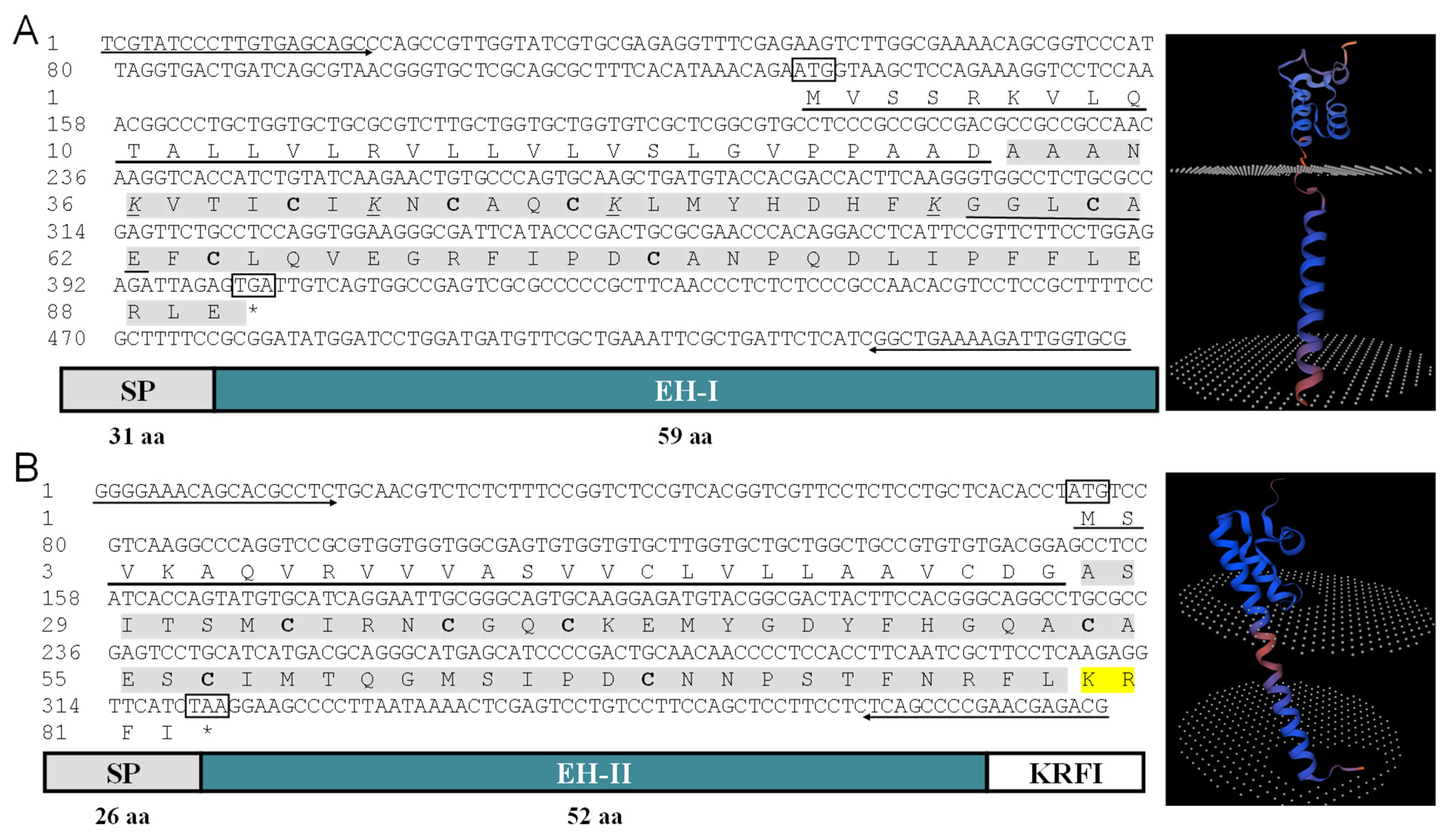
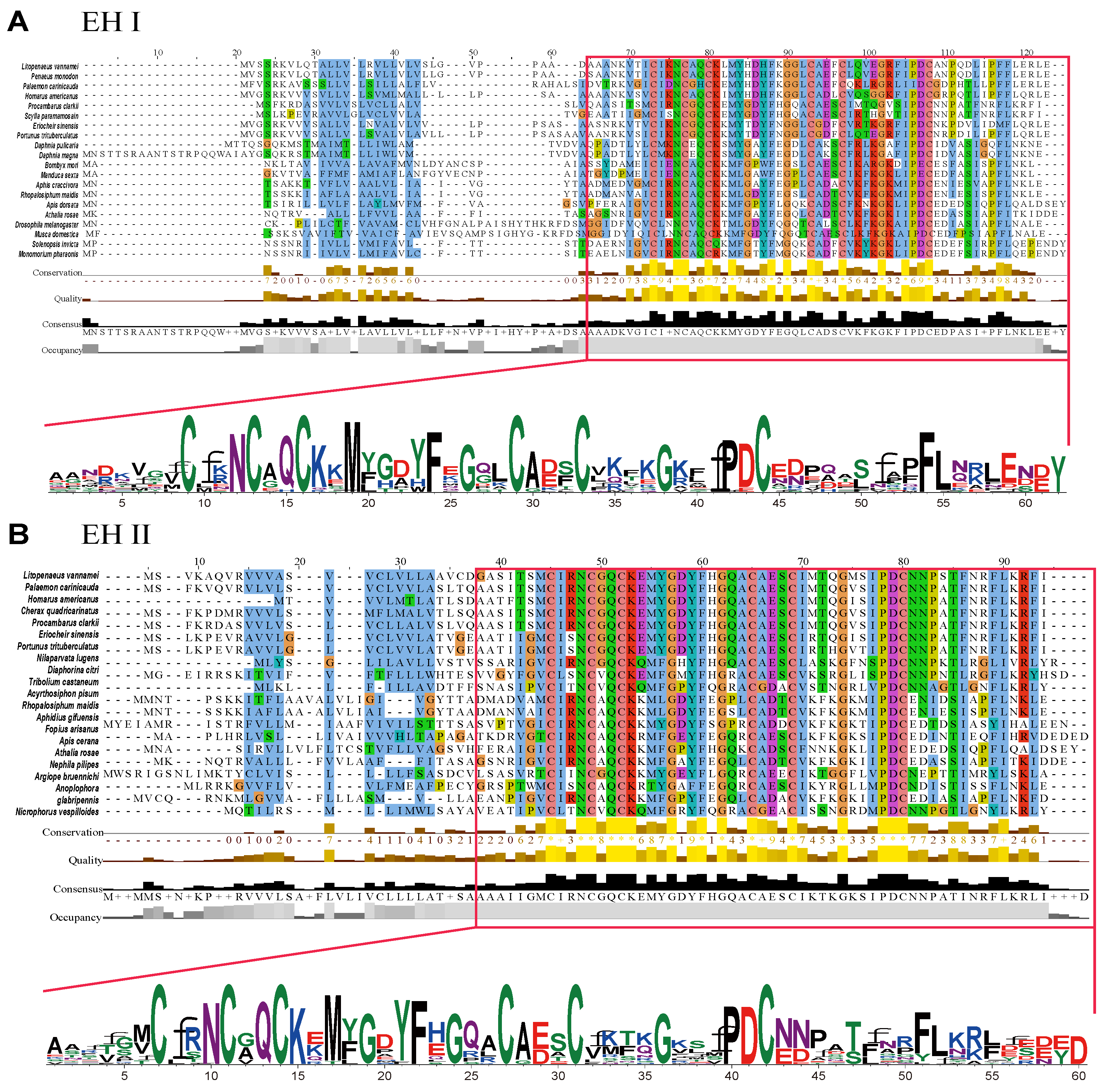

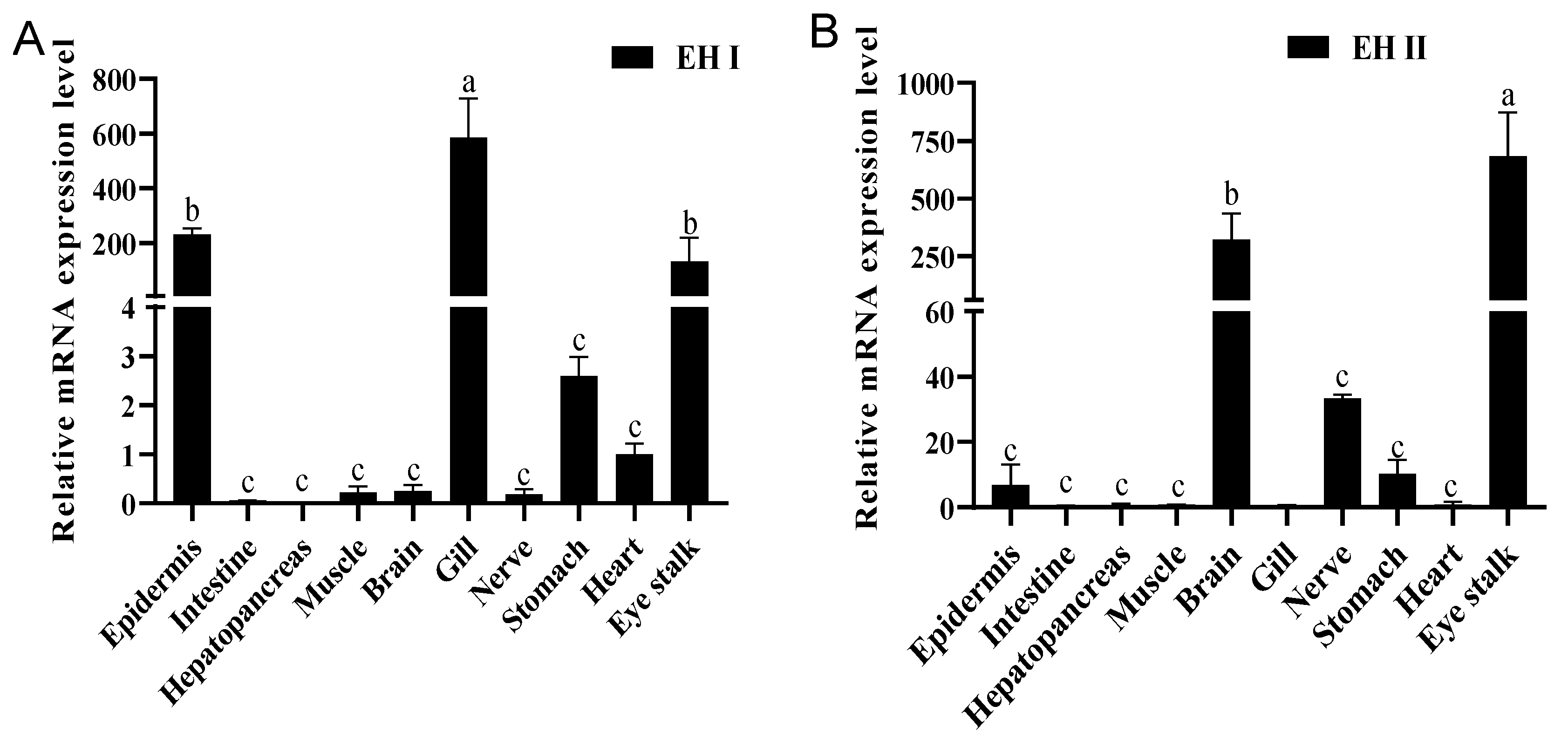
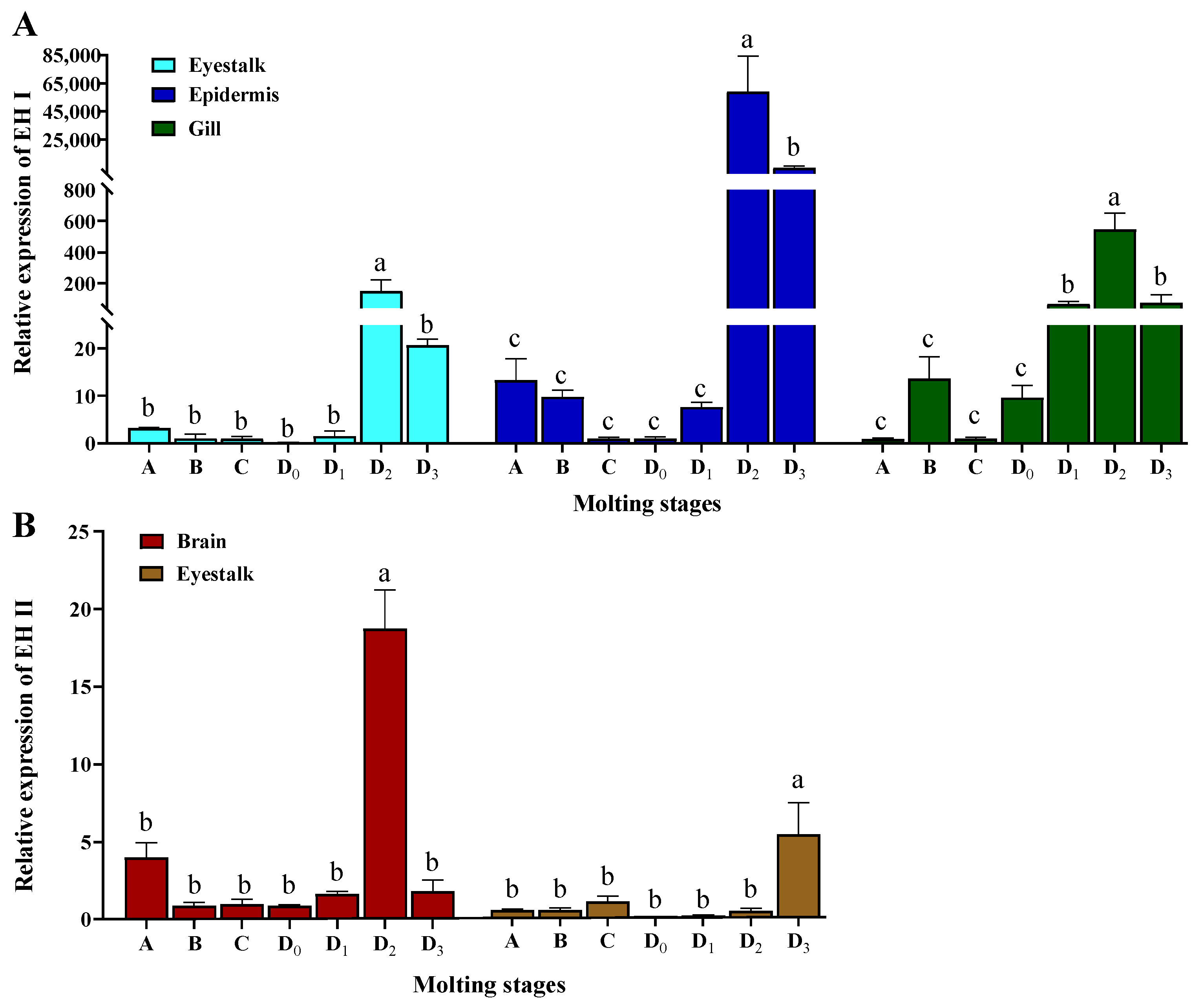
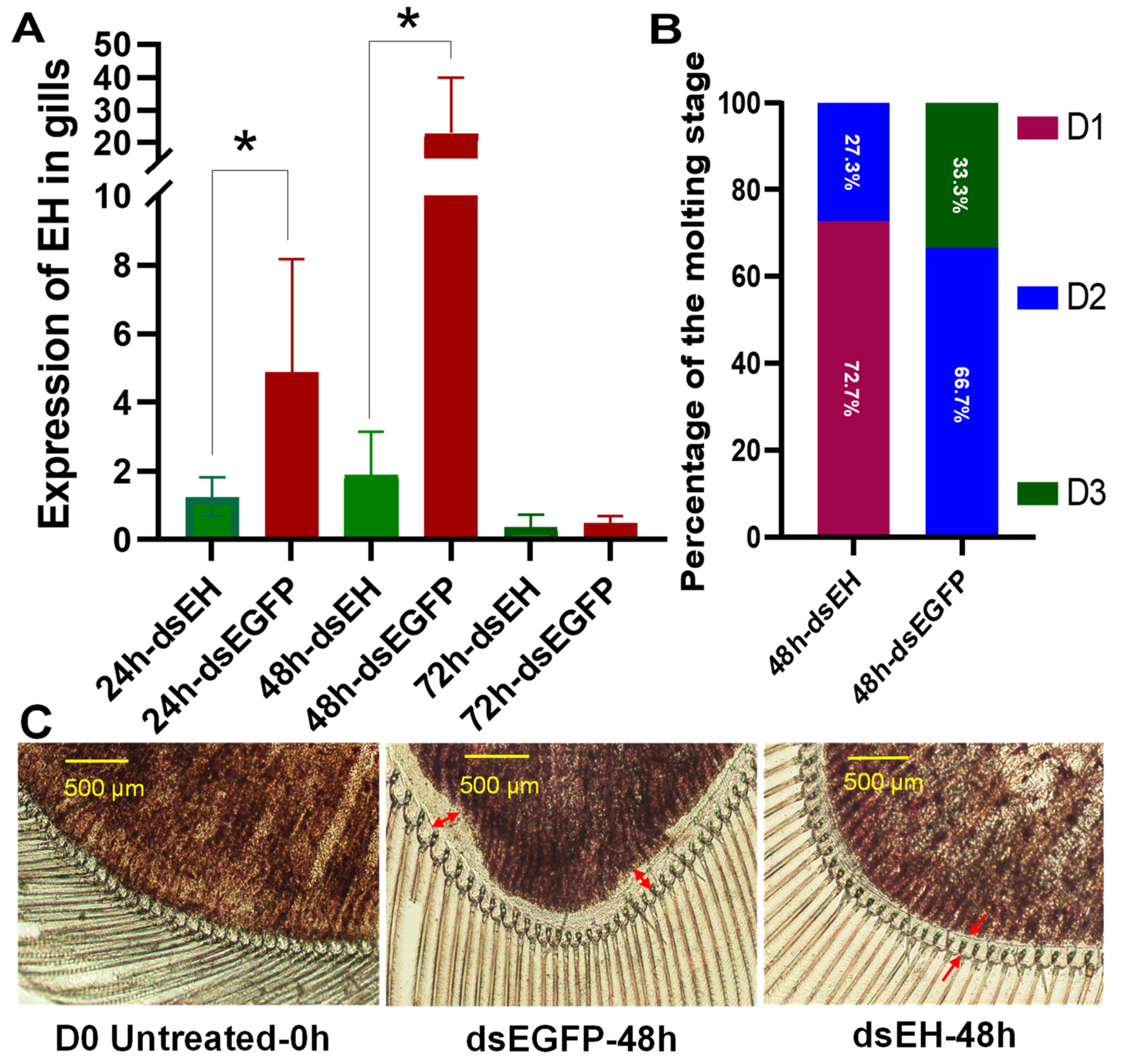
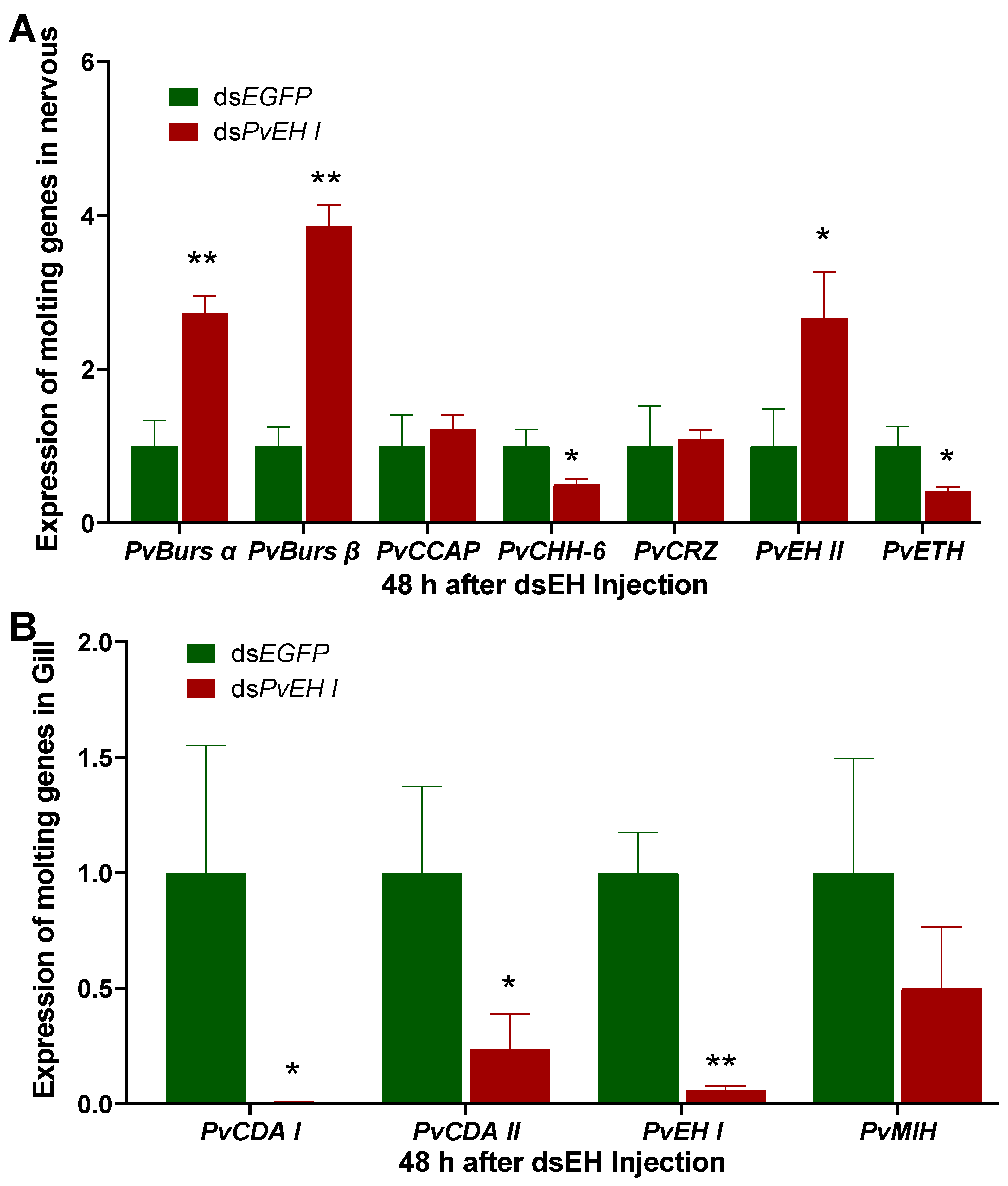
| Primer Name | Primer Sequence (5′–3′) | Applications |
|---|---|---|
| PvEH I-F | TCGTATCCCTTGTGAGCAGC | LvEH I cloning |
| PvEH I-R | CGCACCAATCTTTTCAGC | |
| PvEH II-F | GGGGAAACAGCACGCCTC | LvEH II cloning |
| PvEH II-R | CGTCTCGTTCGGGGCTGA | |
| PvEH I-qF | GCTGATGTACCACGACCACT | qRT–PCR/synthesized dsRNA |
| PvEH I-qR | AATGAGGTCCTGTGGGTTCG | qRT–PCR/synthesized dsRNA |
| PvEH II-qF | GCAGTGCAAGGAGATGTACG | qRT–PCR |
| PvEH II-qR | AGGAAGCGATTGAAGGTGGAG | qRT–PCR |
| β-actin-qF | CGAGAAATCGTTCGTGAC | qRT–PCR |
| β-actin-qR | GATGGAGTTGTAGGTGGTCT | qRT–PCR |
| 18S rRNA-qF | TATACGCTAGTGGAGCTGGAA | qRT–PCR |
| 18S rRNA-qR | GGGGAGGTAGTGACGAAAAAT | qRT–PCR |
| EF1-α-qF | TGGCTGTGAACAAGATGGAC | qRT–PCR |
| EF1-α-qR | AGATGGGGATGATTGGGACC | qRT–PCR |
| EGFP-F | GCAGTGCTTCAGCCGCTAC | synthesized dsRNA |
| EGFP-R | GCTTCTCGTTGGGGTCTTTG | synthesized dsRNA |
| T7-EGFP-F | TAATACGACTCACTATAGGGGCAGTGCTTCAGCCGCTAC | synthesized dsRNA |
| T7-EGFP-R | TAATACGACTCACTATAGGGGCTTCTCGTTGGGGTCTTTG | synthesized dsRNA |
| T7-PvEH I-F | TAATACGACTCACTATAGGGTCGTATCCCTTGTGAGCAGC | synthesized dsRNA |
| T7-PvEH I-R | TAATACGACTCACTATAGGGCGCACCAATCTTTTCAGCC | synthesized dsRNA |
| PvCDA I-F | CAACTCGTTCGAACCCTGGA | qRT–PCR |
| PvCDA I-R | ACTCGTTCTTGAGCCAAGGG | qRT–PCR |
| PvCDA II-F | TGGGGCTTCCTCTACGACT | qRT–PCR |
| PvCDA II-R | GACACTTGTGGGGCATACG | qRT–PCR |
| PvMIH-F | TTGAGAAGCTGCTGTCGTCC | qRT–PCR |
| PvMIH-R | GCGTAGCAGTTACTCTTGCAC | qRT–PCR |
| PvBurs α-F | GTCATATCCGGGCTGCAACT | qRT–PCR |
| PvBurs α-R | CCTGACTCCTGGCAACACAT | qRT–PCR |
| PvBurs β-F | CCCTCCGTCAACACTCCTTC | qRT–PCR |
| PvBurs β-R | CGAATTCCCGCACTTGAAGC | qRT–PCR |
| PvCCAP-F | TATTGTTGGCTGCCCATTCCC | qRT–PCR |
| PvCCAP-R | CTTCGGCGACGATGTGCTT | qRT–PCR |
| PvCHH-6-F | AAGATCGCCTTCGTCTCTGC | qRT–PCR |
| PvCHH-6-R | CGTCGAAGACCTGCCTCTTT | qRT–PCR |
| PvCRZ-F | CTCCACCAGAACGCTGCTTA | qRT–PCR |
| PvCRZ-R | GTCGCCACCAGAGGAAAGAT | qRT–PCR |
| PvETH-F | GTTCCACCTGGAAGCGCGA | qRT–PCR |
| PvETH-R | GTCTCGGCGAAGAAATGCCC | qRT–PCR |
Disclaimer/Publisher’s Note: The statements, opinions and data contained in all publications are solely those of the individual author(s) and contributor(s) and not of MDPI and/or the editor(s). MDPI and/or the editor(s) disclaim responsibility for any injury to people or property resulting from any ideas, methods, instructions or products referred to in the content. |
© 2024 by the authors. Licensee MDPI, Basel, Switzerland. This article is an open access article distributed under the terms and conditions of the Creative Commons Attribution (CC BY) license (https://creativecommons.org/licenses/by/4.0/).
Share and Cite
Li, Y.; Li, Z.; Ran, H.; Fan, Z.; Yang, F.; Chen, H.; Zhou, B. Characterization and Analysis of the Functional Differences of the Two Eclosion Hormones in Regulating Molting in the White Shrimp Litopenaeus vannamei. Int. J. Mol. Sci. 2024, 25, 12813. https://doi.org/10.3390/ijms252312813
Li Y, Li Z, Ran H, Fan Z, Yang F, Chen H, Zhou B. Characterization and Analysis of the Functional Differences of the Two Eclosion Hormones in Regulating Molting in the White Shrimp Litopenaeus vannamei. International Journal of Molecular Sciences. 2024; 25(23):12813. https://doi.org/10.3390/ijms252312813
Chicago/Turabian StyleLi, Yunjiao, Zecheng Li, Hongmei Ran, Zihan Fan, Fan Yang, Hu Chen, and Bo Zhou. 2024. "Characterization and Analysis of the Functional Differences of the Two Eclosion Hormones in Regulating Molting in the White Shrimp Litopenaeus vannamei" International Journal of Molecular Sciences 25, no. 23: 12813. https://doi.org/10.3390/ijms252312813
APA StyleLi, Y., Li, Z., Ran, H., Fan, Z., Yang, F., Chen, H., & Zhou, B. (2024). Characterization and Analysis of the Functional Differences of the Two Eclosion Hormones in Regulating Molting in the White Shrimp Litopenaeus vannamei. International Journal of Molecular Sciences, 25(23), 12813. https://doi.org/10.3390/ijms252312813






